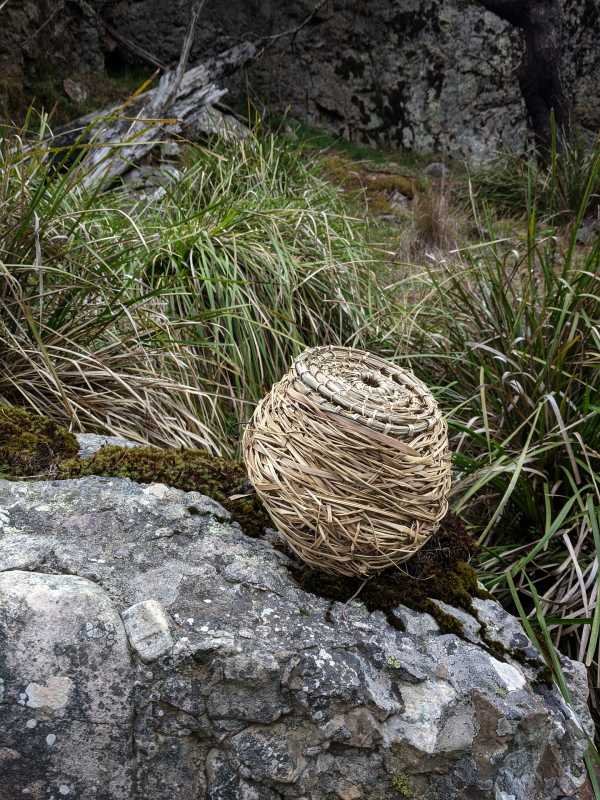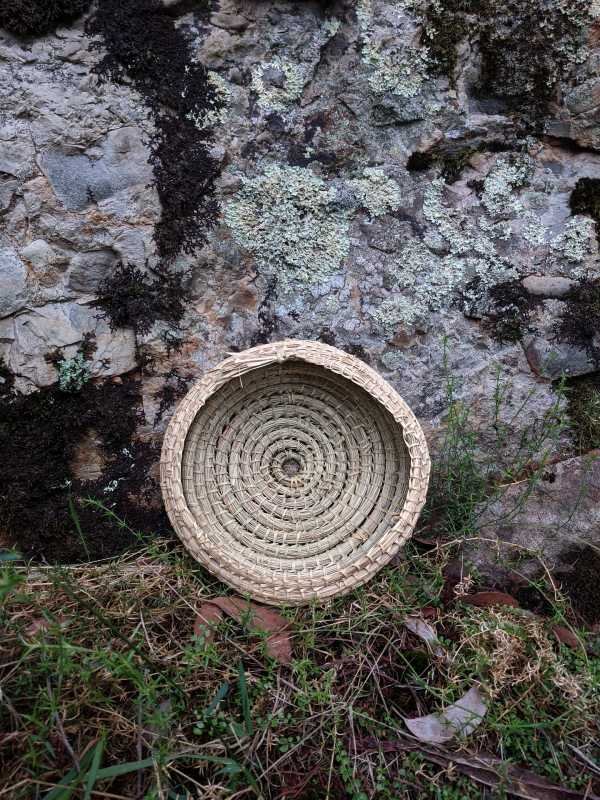The Conversation of Weaving – by RT Wenzel
ISLAND | ONLINE ONLY1. Listening
I am not a self-taught weaver, but taught by the baskets themselves: a gifted basket using eel-trap techniques; two thrifted, age-brittle flax baskets, spliced and braided; the extraordinary collection of moody, low-lit weavings at Okains Bay museum, chance encountered. My eyes and hands recognise the diagonals and crosses, the ribs and the spokes, the warp and weft of organic material, even before I learn a new technique. Someone in my ancestral line knew these shapes, these patterns; my fingers echo the hands of unseen teachers. But my teachers are primarily the plants. Each plant has stories and preferences, and the conversation changes between seasons, storms, lunar phases.
Basketmaking is not a spiritual practice for me, but a deeply practical one. The practice quiets my neuroses and connects me back to my hands and body, to responsive problem-solving. Many repetitive, embodied tasks hold this potential, but the exploration of my local terrain for materials, the seasonal relationship with the plants, the meditation of the stitches, are holistic antidotes to the overwhelm of modern life.
Basketmaking starts with listening to the plant folk, the leaf and grass people, dreamed into a vessel. The vessel itself isn’t important. Wildcrafting is just a lovely way to get to know a new plant friend. ‘Practice’ describes best what it is I am doing here, committing to a process as it unfolds, with no expectations of results or gain. The fingers naturally grow more dexterous, if a little worn and weary, but the gleanings are subtle, meandering, and there are no goalposts. Perhaps the richest part of the practice is that it opens up an earthy conversation with things outside myself, a conversation grounded in soil. I’m a living, breathing thing, and by measure of that, I need company. But company comes in unlimited forms, and much can be communicated in comfortable silences.
2. Talking to plants
Plant-language moves at a different pace to human languages. A good beginning to open the conversation is to sit with a plant long enough to start noticing things beyond its taxonomy. That it’s changing, sitting there. That it has certain likes and dislikes. That it is aquiver with responses, adaptations, and knowledge. English is not useful in this exchange, except sometimes to bridge that initial transition between human and more-than-human, so the plant gets used to you: your presence, your voice. Sometimes the conversation doesn’t become friendly until many years of acquaintance.
The conversation starts before the harvest, and it unfolds with good questions from the weaver. I wonder if this flax prefers a haircut on a waxing or waning moon, in spring or autumn? Does this lomandra want another season to stretch in? Is this willow willing, or does it need to break bud and shake its mane down for another spring? The plants answer directly, with a little time. Observing how the plant fares after a trim in different conditions gives qualitative data to work with, as long as you accept that a plant might change its mind down the track.
Once the materials are brown, a more subtle inquiry is conducted into a material no longer alive, but still responsive. Testing how thirsty the fibers are, in that pliable spot after rehydration but before they split or ferment. Sometimes a dried plant will reject rain after fire or storms, or welcome those pollutants as a necessary parameter to soften or darken. It may be one of the many plants that love the running water of a river or stream to relax in, before I coax it into a new shape. The plant will direct this shape, not me. Will the whips relax into a tight circle, or arc into an oval? Does the basket want reinforcing, or to come undone? My hands have little say in the matter, as my skin greens and my nails blacken. They’re only a conduit to the basket’s becoming.
3. The plants talk back
The baskets I made were personal, and I did not want to sell them. I had roomfuls. Baskets as containers, baskets as bookends, baskets balanced precariously on top of each other because I could not put nails in the rental walls (otherwise I would’ve had walls of baskets. A beautiful, organic, desiccating cavern.) I gave many away. But the others gathered dust, and some began to dissolve.
They were dying.
One day, I took a basket out foraging, and was startled to remember that to make it I’d harvested the dianella only a stone’s throw from the blackberry thicket. It seemed natural to take the basket to visit its ancestors, and when I sat it amongst the strappy leaves, the basket seemed … happy. As if it were yarning with its old mates. I realised that this was a missing element: that the basket had a voice of its own, and it did not reach its ultimate purpose when I tucked in the last weaver. It still wanted to be participating in the world, not static on a mantlepiece.
I returned other baskets to their birthplaces, and I came to understand their mother-plants in a wider context than just their yield. A basket was not just an exchange between my hands and a plant, but part of a much wider conversation. I noticed how the plants interacted with their neighbours, reacted to rock or water or shade, to weather patterns and climate change. All this data was in the basket, too. The baskets were not just of the plants, but of the air, the rock, the moss, the light. The baskets lost their importance as objects and became another part of a symbiotic landscape. I let them converse with all their relations, and if it felt like they wanted to settle into a deeper conversation with soil or clay, I left them behind to compost. The ones that came home again no longer felt dying, but re-animated.
To return my crafting to where it was born has become a frequent and necessary conclusion to my process. It’s the last chapter of making something. Sometimes I take a picture to share and remember that resonance, that the basket is not just an object but an overlapping entity in a system of overlapping entities. Whether the attunement is deep listening to the plants or simply a symbol and reminder of our interconnectedness, it is a nourishing conversation to have. These baskets arose from a need to hold space for a certain conversation, and now desiccate back into soil, not leaving a hard imprint, but becoming a house for woodlice, food for worms. Now that they have been returned, the longing in that beautiful word, to be-long, is met. ▼
Images supplied by the author
If you liked this piece, please share it. And please consider donating or subscribing so that we can keep supporting writers and artists.



